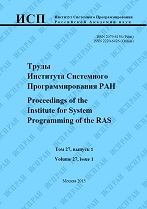|
Simulation of the wedge-shaped vibration-driven robot motion in the viscous fluid forced by different laws of internal mass movement in the package OpenFOAM
A. N. Nurievab, A. I. Yunusovac, O. N. Zaitsevab
a Nizhny Novgorod State University
b Kazan Federal University
c Kazan State Technological University
Abstract:
The work is devoted to the study of the two-mass vibration-driven system motion in the viscous fluid. The system consists of a closed wedge-shaped body, placed in a fluid, and a movable internal mass, oscillated harmonically inside the shell. The described mechanical system simulates a vibration-driven robot. The complex model of the robot interaction with the medium is considered, where fluid motion is described by the full unsteady Navier-Stokes equations. The problems of improving the efficiency of vibration-driven robot motion by choosing a special law internal mass movement are investigated. For these purposes, a comparative analysis of the characteristics of the motion and flow regimes around the robot are carried out for the simple harmonic law of the internal mass motion and the special two-phase law of the internal mass motion. The analysis of the flows around the robot and their influence on the characteristics (the average speed and the efficiency) of the movement is carried out. The numerical solution of the problem is carried out in the OpenFOAM open-source software package. The numerical scheme is implemented on the basis of the finite-volume discretization approach. For joint solution the Navier-Stokes equations and the mechanical system, which describes the interaction of components of vibration-driven robot and viscous media, a special iteration scheme is constructed. Results of the study show that the directional movement of the wedge-shaped vibration-driven robot is possible for both harmonic and two-phase laws of internal mass motion. In each of the cases it is possible to find stable regimes of motion observed in a wide range of Reynolds numbers. Analysis of average speed and efficiency of regimes allows finding the optimal parameters of vibration-driven robot motion.
Keywords:
Vibration-driven robot, Viscous fluid, Navier-Stokes equations, Motion regimes, Motion efficiency, OpenFOAM.
Citation:
A. N. Nuriev, A. I. Yunusova, O. N. Zaitseva, “Simulation of the wedge-shaped vibration-driven robot motion in the viscous fluid forced by different laws of internal mass movement in the package OpenFOAM”, Proceedings of ISP RAS, 29:1 (2017), 101–118
Linking options:
https://www.mathnet.ru/eng/tisp103 https://www.mathnet.ru/eng/tisp/v29/i1/p101
|

| Statistics & downloads: |
| Abstract page: | 179 | | Full-text PDF : | 49 | | References: | 38 |
|




 Contact us:
Contact us: Terms of Use
Terms of Use
 Registration to the website
Registration to the website Logotypes
Logotypes








 Citation in format
Citation in format 